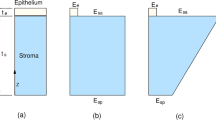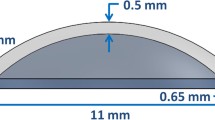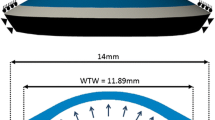Abstract
The human cornea (the external lens of the eye) has the macroscopic structure of a thin shell, originated by the organization of collagen lamellae parallel to the middle surface of the shell. The lamellae, composed of bundles of collagen fibrils, are responsible for the experimentally observed anisotropy of the cornea. Anomalies in the fibril structure may explain the changes in the mechanical behavior of the tissue observed in pathologies such as keratoconus. We employ a fiber-matrix constitutive model and propose a numerical model for the human cornea that is able to account for its mechanical behavior in healthy conditions or in the presence of keratoconus under increasing values of the intraocular pressure. The ability of our model to reproduce the behavior of the human cornea opens a promising perspective for the numerical simulation of refractive surgery.
Similar content being viewed by others
References
Anderson K, El-Sheikh A, Newson T (2004) Application of structural analysis to the mechanical behavior of the cornea. J R Soc Interface 1:1–13
Bryant MR, Marchi V, Juhasz T (2000) Mathematical models of picosecond laser in situ keratomileusis for high myopia. J Refract Surg 16:155–162
Bryant MR, McDonnell PJ (1996) Constitutive laws for biomechanical modeling of refractive surgery. J Biomech Eng 118:473–481
Bryant MR, Szerenyi K, Schmotzer H, McDonnel PJ (1994) Corneal tensile strength in fully healed radial keratotomy wounds. Invest Ophthalmol Vis Sci 35:3022–3031
Daxer A, Fratzl P (1997) Collagen fibril orientation in the human corneal stroma and its implication in keratoconus. Invest Ophthalmol Vis Sci 38:121–129
Duffey RJ, Learning D (2003) US trends in refractive surgery: 2002 ISRS survey. J Refract Surg 19:357–363
Duffey RJ, Learning D (2005) US trends in refractive surgery: 2003 ISRS/AAO survey. J Refract Surg 21:87–91
Guarnieri FA (1999) Modelo biomecanico del ojo para diseno asistido por computadora de la cirurgua refractiva. PhD Thesis, Universidad Nacional del Litoral, Santa Fe, Argentina
Hjortdal JO (1996) Regional elastic performance of the human cornea. J Biomech 29:931–942
Hoeltzel DA, Altman P, Buzard K, Choe K-I (1992) Strip extensiometry for comparison of the mechanical response of bovine, rabbit, and human corneas. J Biomech Eng 114:202–214
Holzapfel GA (2000) Nonlinear solid mechanics: a continuum approach for engineering. Wiley, New York
Holzapfel GA, Gasser TC, Ogden RW (2000) A new constitutive framework for arterial wall mechanics and a comparative study of material models. J Elast 61:1–48
Holzapfel GA, Weizsäcker HW (1998) Biomechanical behavior of the arterial wall and its numerical characterization. Comp Biol Med 28:337–392
Huang Y, Tuft SJ, Meek M (1996) Histochemical and X-ray diffraction study of kerato conus epikeratoplasty, report of two cases. Cornea 15:320–328
Jayasuriya AC, Ghosh S, Scheinbeim JI, Lubkin V, Bennett G, Kramer P (2003) A study of piezoelectric and mechanical anisotropies of the human cornea. Biosens Bioelectron 18:381–387
Kaliske M (2000) A formulation of elasticity and viscoelasticity for fibre reinforced material at small and finite strains. Comput Methods Appl Mech Eng 185:225–243
Lanir Y (1979) A structural theory for the homogeneous biaxial stress-strain relationships in flat collagenous tissues. J Biomech 12: 423–436
Le Tallec P, Rahier C, Kaiss A (1993) Three-dimensional incompressible viscoelasticity in large strains: formulation and numerical approximation. Comput Methods Appl Mech Eng 109:233–258
Meek KM, Newton RH (1999) Organization of collagen fibrils in the corneal stroma in relation to mechanical properties and surgical practice. J Refract Surgery 15:695–699
Meek KM, Blamires T, Elliott GF, Gyi TJ, Nave C (1987) The organisation of collagen fibrils in the human corneal stroma: a synchroton X-ray diffraction study. Curr Eye Res 6:841–846
Merodio J, Ogden RW (2003) Instabilities and loss of ellipticity in fiber-reinforced com pressible non-linearly elastic solids under plane deformation. Int J Solids Struct 40:4707–4727
Merodio J, Ogden RW (2005) On tensile instabilities and ellipticity loss in fiber-reinforced incompressible non-linearly elastic solids. Mech Res Commun 32:290–299
Newton RH, Meek KM (1998a) Circumcorneal annulus of collagen fibrils in the human limbus. Invest Ophthalmol Vis Sci 39:1125–1134
Newton RH, Meek KM (1998b) The integration of the corneal and limbal fibrils in the human eye. Biophys J 75:2508–2512
Petroll WM, Roy P, Chuong CJ, Hall B, Cavanagh HD, Jester JV (1996) Measure ment of surgically induced corneal deformations using three-dimensional confocal microscopy. Cornea 15:154–164
Pinsky PM, Datye DV (1991) A microstructurally-based finite element model of the incised human cornea. J Biomech 24:907–922
Pinsky PM, Datye DV (1992) Numerical modeling of radial, astigmatic and hexagonal keratotomy. Refract Corneal Surg 8:164–172
Pinsky PM, van der Heide D, Chernyak D (2005) Computational modeling of mechanical anisotropy in the cornea and sclera. J Cataract Refract Surg 31:136–145
Rabinowitz YS (1998) Keratoconus. Surv Ophthalmo 42:297–319
Seiler T, Matallana M, Sendler S, Bende T (1992) Does Bowman’s layer determine the biomechanical properties of the cornea?. Refract Corneal Surg 8:139–142
Shin TJ, Vito RP, Johnson LW, McCarey BE (1997) The distribution of strain in the human cornea. J Biomech 30:497–503
Simo JC, Miehe C (1992) Assocative coupled thermoplasticity at finite strains: Formula tion, numerical analysis and implementation. Comput Methods Appl Mech Eng 98:41–104
Soergel F, Jean B, Seiler T, Bende T, Mucke S, Pechhold W, Pels L (1995) Dynamic mechanical spectroscopy of the cornea for measurement of its viscoelastic properties in vitro. Ger J Ophthalmol 4:151–156
Spencer AJM (1972) Deformations of fibre-reinforced materials. Oxford Science Research, Papers, Oxford University Press, Oxford
Thompson JF, Soni BK, Weatherrill NP (1998) Handbook of Grid Generation. CRC Press, Boca Raton
Treloar LRG (1975) The physics of rubber elasticty. Clarendon Press, Oxford
Uchio E, Ohno S, Kudoh J, Aoki K, Kisielewicz LT (1999) Simulation model of an eyeball based on finite element analysis on a supercomputer. Br J Ophthalmol 83:1106–1111
Wang JQ, Zeng YJ, Li XY (2000) Influence of some operational variables on the radial keratotomy operation. Br J Ophthalmol 84:651–653
Wollensak G, Spoerl E, Seiler T (2003) Stress-strain measurements of human and porcine corneas after riboflavin-ultraviolet-a-induced cross-linking. J Cataract Refract Surg 29:1780–1785
Zeng Y, Yang J, Huang K, Lee Z, Lee X (2001) A comparison of biomechanical properties between human and porcine cornea. J Biomech 34:533–537
Author information
Authors and Affiliations
Corresponding author
Rights and permissions
About this article
Cite this article
Pandolfi, A., Manganiello, F. A model for the human cornea: constitutive formulation and numerical analysis. Biomech Model Mechanobiol 5, 237–246 (2006). https://doi.org/10.1007/s10237-005-0014-x
Received:
Accepted:
Published:
Issue Date:
DOI: https://doi.org/10.1007/s10237-005-0014-x




